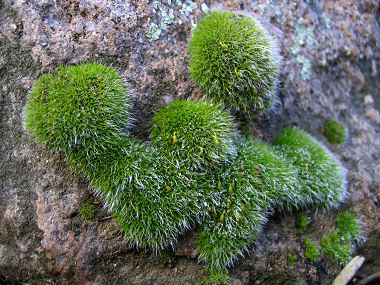Moss is a member of a division of plants
called bryophytes. Bryophytes are simple, non-vascular
 plants
which have no roots, stems, or leaves.
There are approximately 10,000 species of mosses, but they generally
appear as small, soft, plants which grow to 4 inches in height in clumps
or mats. plants
which have no roots, stems, or leaves.
There are approximately 10,000 species of mosses, but they generally
appear as small, soft, plants which grow to 4 inches in height in clumps
or mats.
|
Moss has an important role in
nature; they grow on bare rock and contribute to soil development,
form thick carpets that can reduce erosion and they act like a
sponge retaining and slowly releasing water. |
Because they have no roots mosses must take in
moisture through their 'leaves'. As a result they are found chiefly in
areas of low light and high humidity. They are common in wooded areas
and at the edges of streams. Mosses evolved approximately 350 million
years ago, before dinosaurs, reptiles, birds and insects. At this time
flowers and seeds had not yet evolved due to the fact that there were
no creatures around to perform pollination. Instead mosses reproduce
through spores. The advantage of spores is that they are small and
lightweight and thus able to be borne long distances upon the wind.
The disadvantage is that they do not contain much stored energy and
therefore have to land in a spot where conditions are ideal in order
to survive.
|

